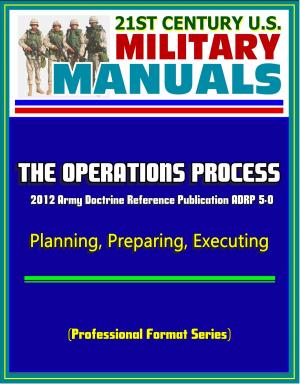The Pentomic Era: The U.S. Army Between Korea and Vietnam - Eisenhower Era Battle over Military Strategy, Atomic Weapons, Battlefield Nuclear Bombs, General Maxwell Taylor, Nike Program
Nonfiction, History, Military, United States| Author: | Progressive Management | ISBN: | 9781301728992 |
| Publisher: | Progressive Management | Publication: | August 1, 2013 |
| Imprint: | Smashwords Edition | Language: | English |
| Author: | Progressive Management |
| ISBN: | 9781301728992 |
| Publisher: | Progressive Management |
| Publication: | August 1, 2013 |
| Imprint: | Smashwords Edition |
| Language: | English |
Although atomic weapons helped win World War Two in the Pacific, they raised the question of whether these weapons altered the nature of warfare, or simply warfare's destructive dimensions. Responsibility for nuclear weapons development became a central issue in US service politics, particularly between the Army and Air Force during the early years of the Eisenhower administration. In his history of the Army in the years between the Korean and Vietnam wars, Lieutenant Colonel A. J. Bacevich, US Army, accents the Army's mindfulness of the implications of nuclear warfare. The Army's concern, reflecting a complex mixing of institutional, strategic, and operational considerations, led to major changes in Army organization, doctrine, and weapons. The author argues that during these years, the Army not only survived an institutional identity crisis—grappling to comprehend and define its national security role in a nuclear age—but grew to meet new challenges by pioneering the development of rockets and missiles. This analysis of the Army's post-Korea, pre-Vietnam era contributes valuable insights to the study of recent US military history. Especially important is the caution that military professionals temper their enthusiasm for technological progress with an eye to those elements of warfare that remain changeless.
This is a brief history of the US Army during the years immediately following the Korean War. For many in our own time that period — corresponding to the two terms of the Eisenhower presidency — has acquired an aura of congenial simplicity. Americans who survived Vietnam, Watergate, and painful economic difficulties wistfully recall the 1950s as a time when the nation possessed a clearly-charted course and had the will and the power to follow it. However comforting such views may be. the reality was far different. Many segments of America experienced the 1950s as anything but a Golden Age. Prominent among this group was the Army. Instead of the "good old days," the Army found the Eisenhower era to be one of continuing crisis. New technology, changing views of the nature of war, and the fiscal principles of the Eisenhower administration produced widespread doubts about the utility of traditional land forces. As Army officers saw it, these factors threatened the well-being of their Service and by implication endangered the security of the United States.
This essay explores the nature of those threats and of the Army's response to them. By design, this essay is selective and interpretive. It does not provide a complete narrative of events affecting the Army after Korea. It excludes important developments such as foreign military assistance, the growth of Army aviation, and the impact of alliance considerations on American military policy. As a result, the history that follows is neither comprehensive nor definitive. What value it may possess derives instead from its explication of themes that retain some resonance for an Army in later decades confronted with its own challenges.
A great institution like the Army always is in transition. And though the character of reform is seldom as profound as the claims of senior leaders or the Army Times may suggest, in the 1950s change often matched the hyperbole of its advocates. The Army found itself grappling for the first time with the perplexing implications of nuclear warfare; seeking ways of adapting its organization and doctrine to accommodate rapid technological advance; and attempting to square apparently revolutionary change with traditional habits and practical constraints of the military art. In retrospect, we may find fault with the Army's response to these challenges. If so, we have all the more reason to concern ourselves with how the Service derived the answers that it did. To a striking extent, challenges similar to those of the 1950s have returned to preoccupy the Army today.
Although atomic weapons helped win World War Two in the Pacific, they raised the question of whether these weapons altered the nature of warfare, or simply warfare's destructive dimensions. Responsibility for nuclear weapons development became a central issue in US service politics, particularly between the Army and Air Force during the early years of the Eisenhower administration. In his history of the Army in the years between the Korean and Vietnam wars, Lieutenant Colonel A. J. Bacevich, US Army, accents the Army's mindfulness of the implications of nuclear warfare. The Army's concern, reflecting a complex mixing of institutional, strategic, and operational considerations, led to major changes in Army organization, doctrine, and weapons. The author argues that during these years, the Army not only survived an institutional identity crisis—grappling to comprehend and define its national security role in a nuclear age—but grew to meet new challenges by pioneering the development of rockets and missiles. This analysis of the Army's post-Korea, pre-Vietnam era contributes valuable insights to the study of recent US military history. Especially important is the caution that military professionals temper their enthusiasm for technological progress with an eye to those elements of warfare that remain changeless.
This is a brief history of the US Army during the years immediately following the Korean War. For many in our own time that period — corresponding to the two terms of the Eisenhower presidency — has acquired an aura of congenial simplicity. Americans who survived Vietnam, Watergate, and painful economic difficulties wistfully recall the 1950s as a time when the nation possessed a clearly-charted course and had the will and the power to follow it. However comforting such views may be. the reality was far different. Many segments of America experienced the 1950s as anything but a Golden Age. Prominent among this group was the Army. Instead of the "good old days," the Army found the Eisenhower era to be one of continuing crisis. New technology, changing views of the nature of war, and the fiscal principles of the Eisenhower administration produced widespread doubts about the utility of traditional land forces. As Army officers saw it, these factors threatened the well-being of their Service and by implication endangered the security of the United States.
This essay explores the nature of those threats and of the Army's response to them. By design, this essay is selective and interpretive. It does not provide a complete narrative of events affecting the Army after Korea. It excludes important developments such as foreign military assistance, the growth of Army aviation, and the impact of alliance considerations on American military policy. As a result, the history that follows is neither comprehensive nor definitive. What value it may possess derives instead from its explication of themes that retain some resonance for an Army in later decades confronted with its own challenges.
A great institution like the Army always is in transition. And though the character of reform is seldom as profound as the claims of senior leaders or the Army Times may suggest, in the 1950s change often matched the hyperbole of its advocates. The Army found itself grappling for the first time with the perplexing implications of nuclear warfare; seeking ways of adapting its organization and doctrine to accommodate rapid technological advance; and attempting to square apparently revolutionary change with traditional habits and practical constraints of the military art. In retrospect, we may find fault with the Army's response to these challenges. If so, we have all the more reason to concern ourselves with how the Service derived the answers that it did. To a striking extent, challenges similar to those of the 1950s have returned to preoccupy the Army today.















